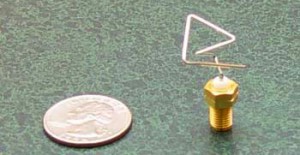Welcome to the Ultraviolet Analytics blog! This will be a sounding board for things we’re working on, things we find interesting and things we want to share. This will typically cover data science topics, but I won’t rule out an occasional cat video (what’s the point of a blog if you can’t post cat videos from time to time).
I’d like to open this blog with one of the coolest things I’ve ever seen. I learned about this back in college (GO WOLFPACK!) and the underlying concept has been one of the driving forces behind my fascination with machine learning and artificial intelligence. Here it is:
It doesn’t look like much does it? If you didn’t read the subtitle of this post you may have absolutely no clue what it is. Maybe something the kid with severe ADD in shop class made from a paperclip while he was supposed to be building a birdhouse? It’s actually an antenna that NASA tested during a mission for new technologies, and it works as well as any human designed antenna. That’s right, machine learning looks like Microsoft Clippy was run over by a bus*.
The algorithm employed in this case is called an Evolutionary Algorithm and it works by symbolically following the principles of biological evolution – a population of potential solutions is evaluated for fitness, then the most successful individuals are “mated” (by combining their representations) and finally mutations are randomly applied, yielding the next generation. Super cool stuff.
What I find so wildly fascinating about this weird paperclip looking thing is that we have no idea why THIS is the most effective antenna. The physics simulation that evaluated the evolving designs expected this thing to work, and when they built and tested it it did. No human would have tried this, and it’s impossible to intuitively understand what’s going on here. This is the power of machine learning. Computers can make discoveries about the world that we simply cannot understand. I’m sure I’ll discuss neural networks quite a bit in this blog (they’re my favorite modeling technique) and they’re another biologically-inspired, human-incomprehensible algorithm that produces incredible results.
* Perhaps the reference to Clippy wasn’t the best one to make when attempting to espouse the success of machine learning. since it was an early and miserable attempt at an intelligent digital assistant. This antenna worked much better than Clippy!
Read more on evolving antennas:
http://en.wikipedia.org/wiki/Evolved_antenna
http://en.wikipedia.org/wiki/Space_Technology_5
http://alglobus.net/NASAwork/papers/Space2006Antenna.pdf
http://idesign.ucsc.edu/projects/evo_antenna.html

